
Join the WPMarmite subscribers
Get the last WPMarmite posts (and also exclusive resources).
It is known as the Island of Beauty. Its breathtaking landscapes, its fine sandy beaches, its turquoise water and its gentle way of life have made its reputation.
That’s it for the tourism part. Did you know that the WordPress history started in Corsica (France)?
Intriguing, isn’t it? The machine took off in the early 2000’s and, in the space of two decades, WordPress has become the number one software in the world for creating websites.
Throughout these lines, you will discover in detail its evolution and its main milestones (features, ecosystem, community, acquisitions).
You will also see that WordPress is inseparable from one man: Matt Mullenweg. But also from a company, Automattic, created by this same… Mullenweg.
At the turn of the year 2000, Michel Valdrighi was a webmaster in an association dedicated to the preservation of the Corsican language.
At the time, this self-taught thirty-year-old created his first project in PHP and MySQL and blogged on the platform… Blogger.
And suddenly: Eureka! In 2001, he launched b2/cafelog. This open-source blog publishing software coded in PHP is based on a database (MySQL). For the record, b2 means Blog 2.
As Michel Valdrighi said during a conference delivered at WordCamp Paris 2011, b2 comes from his “desire to create [his] own Blogger”, associated with “listening to Blur’s “Song 2″”.
The project takes off, ideas bubble up and the first contributions arrive. Matt Mullenweg, a young American saxophonist answering to the pseudo of “saxmatt”, is among the first enthusiasts and contributors. 😉
Unfortunately, after a few months, the b2/cafelog project fell apart. For personal reasons, Valdrighi disappeared from the radar for a few months at the end of 2002, beginning of 2003.
Frustrated by the turn of events, Mullenweg still has an idea: forker b2. That is to say: create a new software from the source code of b2.
He put his plan into action. And that’s how WordPress was born, officially launched on May 27, 2003 in its version 0.7.
“WordPress was born out of a desire to have an elegant, well-architected personal publishing system built in PHP and MySQL and licensed under the GPL” says the page devoted to the history of WordPress on its official website.
Behind this CMS (Content Management System) that will go down in history are two co-founders:
This first version (0.7), which tests the ground, remains minimalist. According to the official WodPress.org website, here is what it includes:
Take a look at what WordPress 1.0 looked like back then:
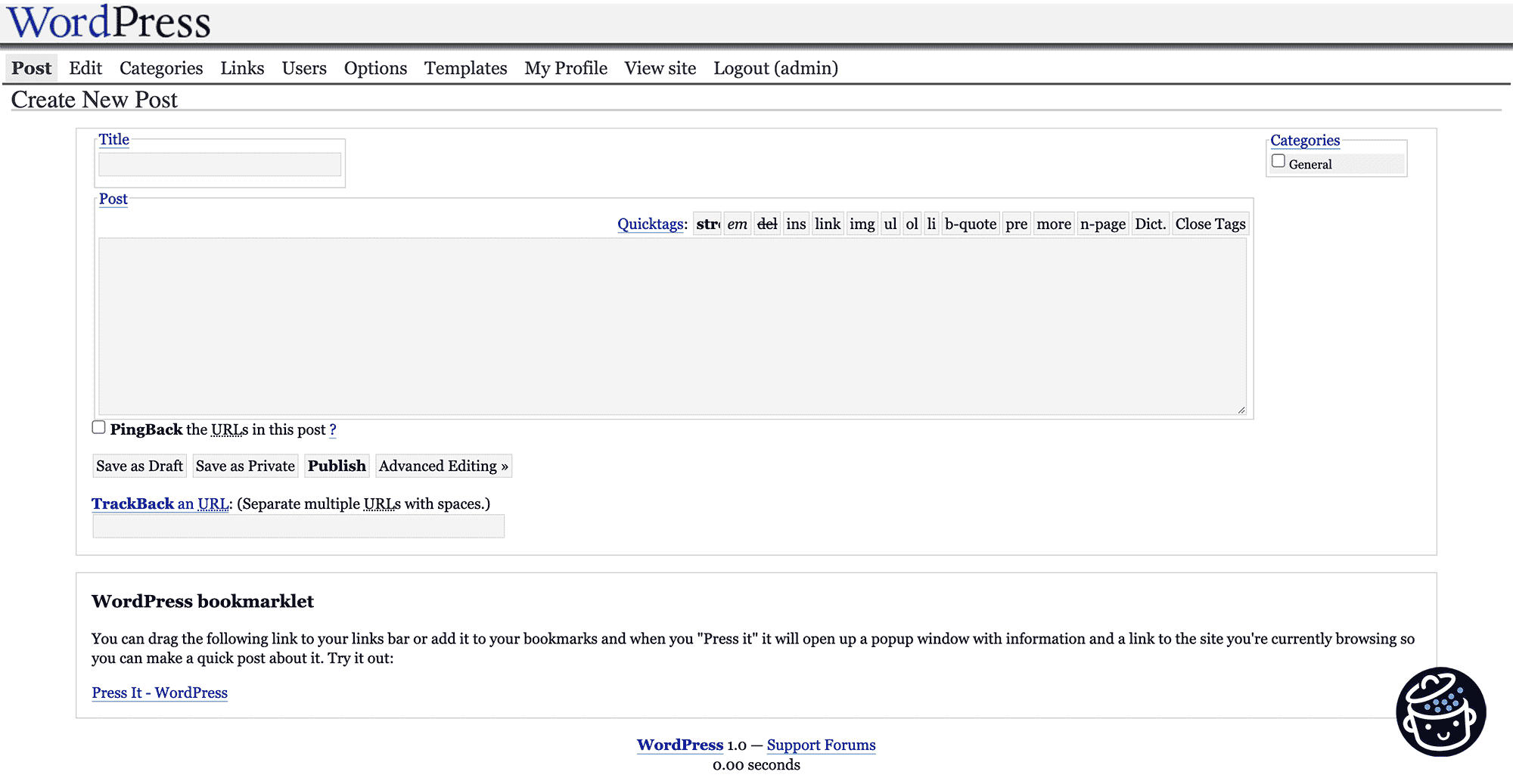
b2 continues its own existence, alongside. It still exists today under the name b2evolution, for your information.
All traces of its name were removed in December 2003 in the file names of WordPress. Files are now called “wp-” (and not “b2”).
Michel Valdrighi, the creator of b2, will even collaborate with WordPress until 2005, ensuring a certain continuity between the two tools.
If b2 is a reference to Blogger and a song by the excellent British rock band Blur, do you know where the name WordPress comes from?
A friend of Matt Mullenweg, Christine Tremoulet, came up with it. She tells it in this podcast episode.
Mullenweg first wanted a name related to print media – and printing in the broadest sense – because the latter had caused a revolution when it was invented by Gutenberg in the 15th century (Gutenberg will come back to the fore later, you’ll see).
And let’s not forget blogging, of course. Written press + blogging: WordPress (literally “Word Press”) was a natural choice! Like a newspaper, if you extrapolate, WordPress gives power to bloggers by allowing them to write and publish on the subjects that are important to them.

Get the last WPMarmite posts (and also exclusive resources).
The official version 1.0 of WordPress was released on January 3, 2004. As it will be customary thereafter, it is named after a famous jazzman: Davis, in reference to Miles Davis.
This first major version includes several features such as :
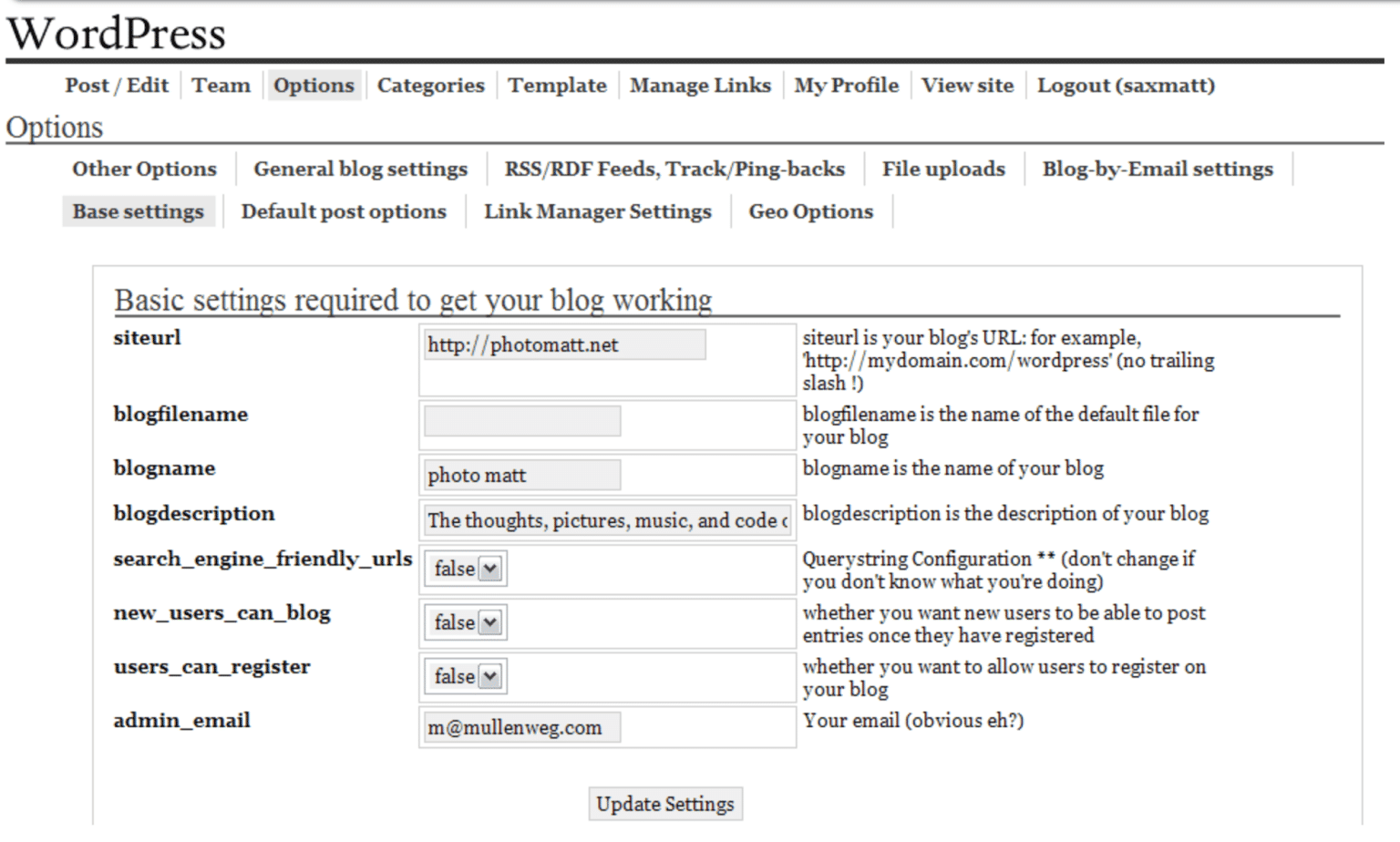
A few months later, on May 22, 2004, version 1.2 was released. “Mingus” introduces the plugins, which allow to add functionalities to the Core of WordPress without touching the code.
There are now on the official directory!
The first plugin to appear is called Hello Dolly, which you can find on every new fresh installation of WordPress.
Created by Matt Mullenweg, Hello Dolly has no technical use. This “decorative” plugin only displays random lyrics of Hello Dolly, a Louis Armstrong song, in the top right corner of each page of your administration.
That’s why we advise you to uninstall it every time you create a WordPress site.
Among the other features introduced, we find for example :
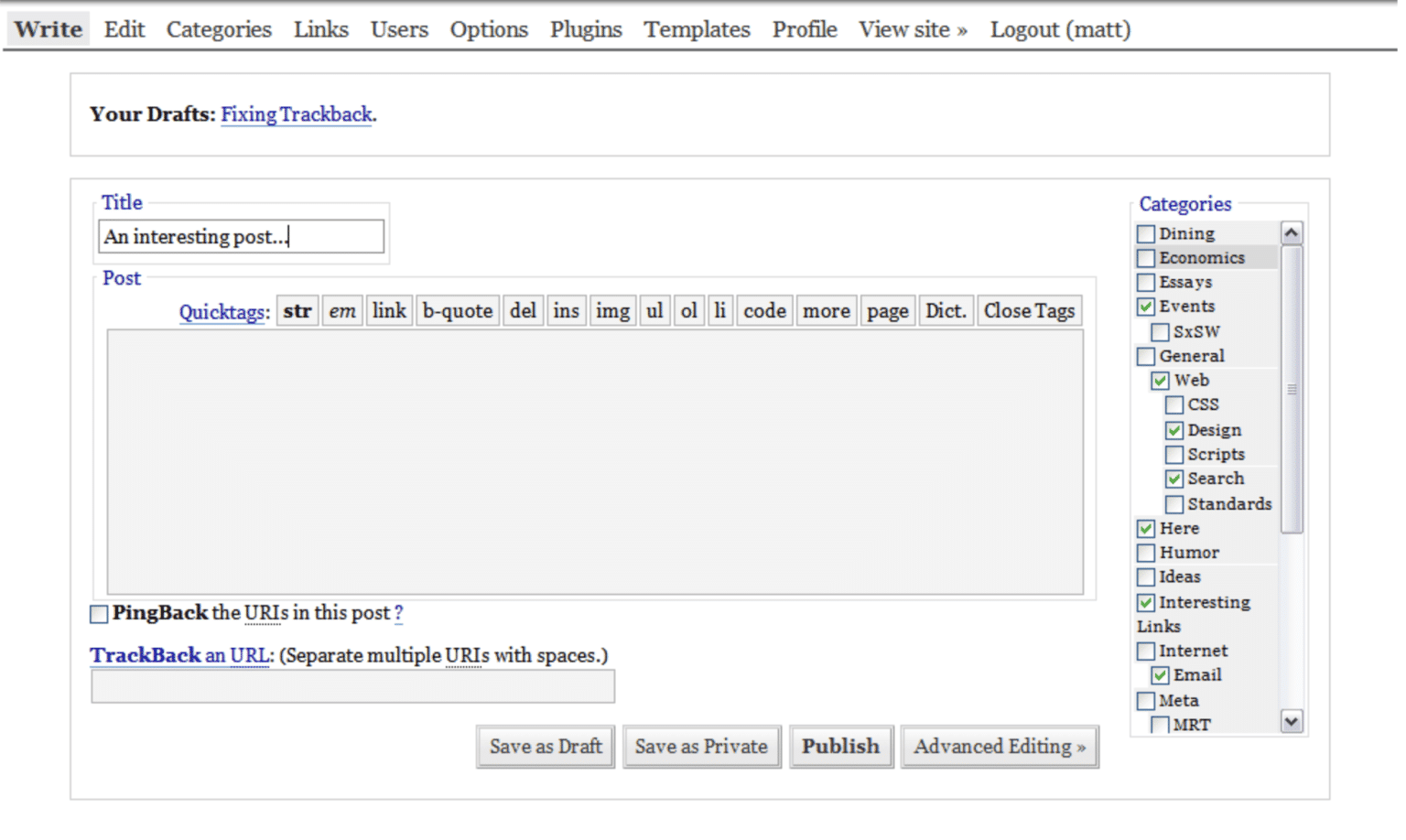
“Version 1.5 (Strayhorn) introduced a Theme system and featured the introduction of static pages, bring WordPress to be poised as a content management system” says WordPress.org.
The first default theme, named Kubrick, is also launched. Another important new feature is the creation of the plugin directory, to connect developers and users.

The 2.0 version of WordPress, named “Duke”, definitively anchors WordPress as a blogging tool. After several months of development, the TinyMCE visual editor is integrated into the WP Core and appears on our screens.
Created by the TinyMCE team and developer Andy Skelton, this open source editor allows you to edit text online, viewing changes in real time (WYSIWYG, What You See Is What You Get).
This revolutionizes content creation, with the ability to upload images, videos and files.
At the same time, permanent caching and a new user role system are introduced. Not to mention the Akismet plugin – still installed by default on WordPress since then – which allows to fight against spam and unwanted comments.
No major version is released in 2006. 2007 and 2008 are two good years with 3 major releases each time:
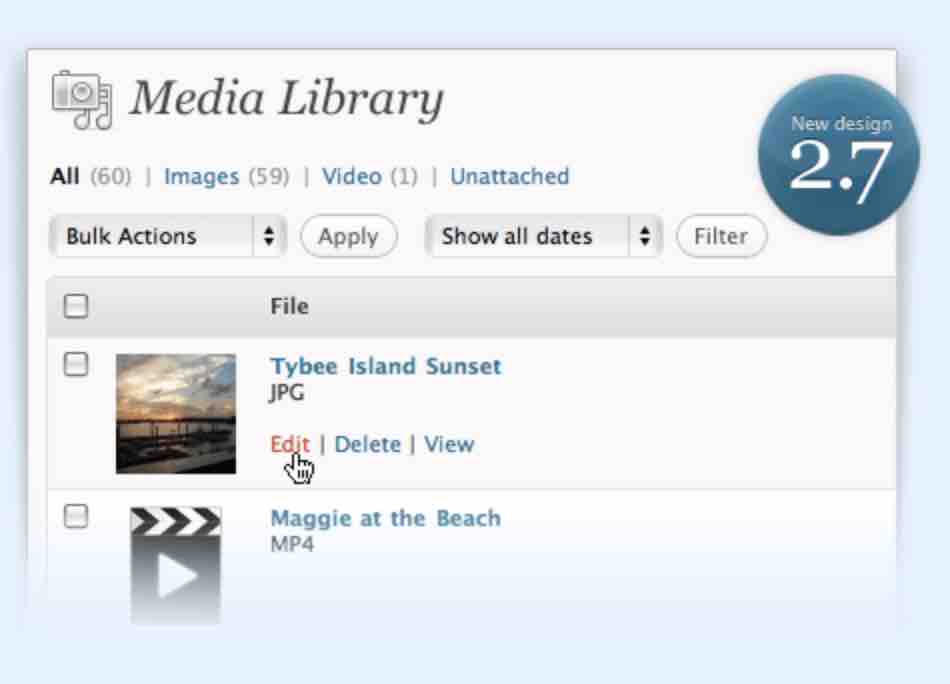
The other event of 2008 is the release of the themes directory, which now has 12,225 entries.
As you can see, it took almost 5 years after the launch of the CMS to welcome this new tool that will quickly become essential, as is its little brother: the plugin directory.
Before starting the turn of the 2010s, WordPress released two versions in 2009:
With the 2010 decade just underway, WordPress kicked into high gear with the release of a major new version – in every sense of the word – in June 2010.
Thelonius (WP 3.0) introduces custom post types that allow to create content different from posts and pages. The management of multiple sites is also proposed, via the integration of the former WordPress MU in the WordPress Core.
This multi-user version of WordPress allowed to create a network of several blogs on the same interface.
Finally, the icing on the cake, a new default theme called Twenty Ten has been added:
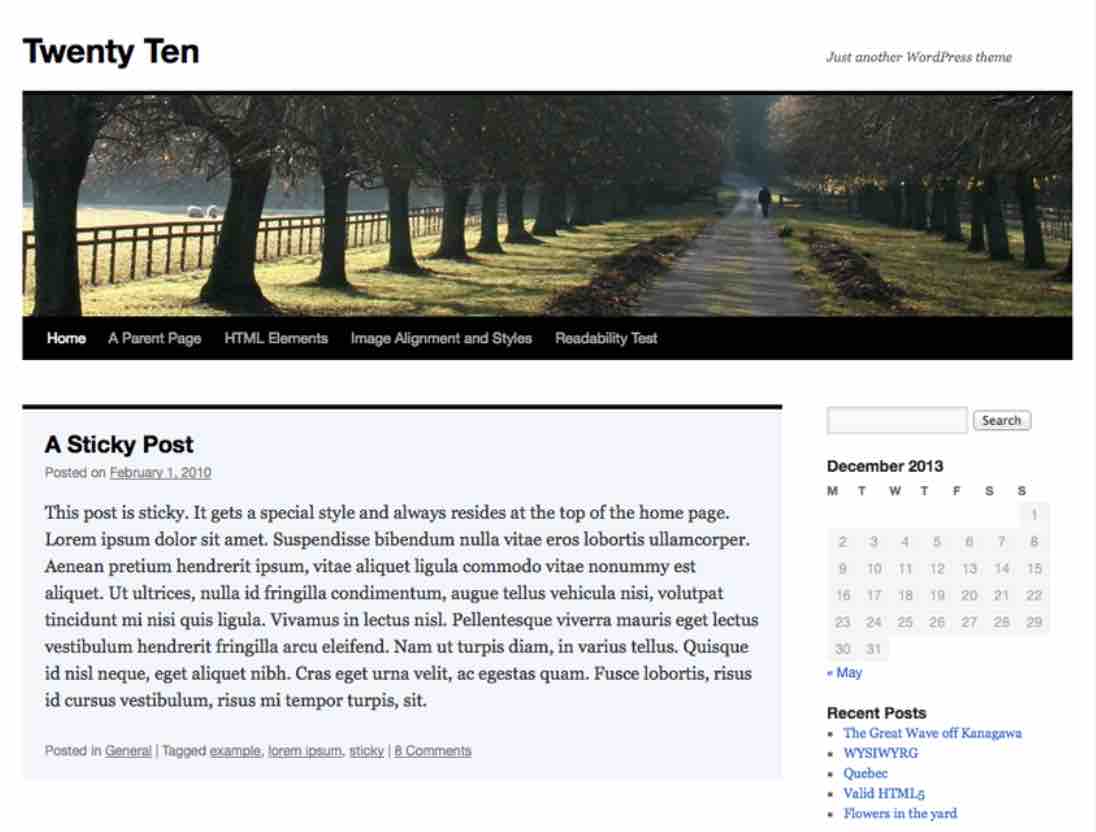
2011 is a prolific year with the release of 3 major versions:
Over the following years, WordPress adopted a cruising rhythm with two to four major releases per year.
Each time, it brings its share of changes with, among the most important:

And then, little by little, a new revolution – yet another one – is coming to the WordPress planet: the arrival of Gutenberg.
The year 2018 is witnessing one of the most important developments of the number one CMS on the market: the release of a new content editor named Gutenberg.
Gutenberg as in Johannes Gutenberg, the inventor of printing in the 15th century. This new content editor that changes everything is embedded in the Core of WordPress version 5.0, called “Bebo”.
This editor replaces the TinyMCE editor, in place since 2005. With Gutenberg, which crystallized the criticism and concerns at the beginning (the wind has been blown back since then), it’s time for blocks.
These are ready-to-use containers that allow you to add the content of your choice (text, images, videos, audio, etc.) in your publications (posts, pages).

All without coding, of course. “The foundation that’ll revolutionize customization and site building in WordPress“, says the page dedicated to Gutenberg, are set.
From now on, the contributors’ efforts will focus mainly on this new WYSIWYG editor.
Its goal is to become, in the long run, a real site builder, in order to position WordPress as an open source alternative to competitors like Wix or Squarespace.
The following versions focus on improving the performance of the editor, adding new features (layouts, styles), or the appearance of new blocks.
In the midst of all this, we can still point out some major milestones.
WordPress 5.5 “Eckstine” integrates a Gutenberg block directory directly into the editor. In addition, this version improves your site on three levels:

To date, it is also the version that has welcomed the most contributors to enable its development, with a total of 805 people!
The year 2020 is also the year of a first. WordPress 5.6 “Simone”, released in December, is the first major release of the CMS led by a 100% female team.
It is headed by Josepha Haden Chomphosy, the current executive director of WP.
By the way, this version extends automatic updates to the WordPress Core on new installations and features a new theme designed for the block editor: Twenty Twenty-One.

2021 sees the pace of major releases slowing down a bit: “only” two major releases are released each year.
It must be said that something big is going on in the background, as you’ll see right after. 😉
In the meantime, WordPress 5.7 “Esperanza” continues to improve the content editor, and allows you to “switch a website from HTTP to HTTPS in one click”.
WordPress 5.8 “Tatum”, released in July 2021, features a major change: widget management using blocks. Also noteworthy is the support for WebP format, which reduces the weight of images and improves the loading speed of your pages.

In 2018, the appearance of Gutenberg kicked some serious butt. Four years later, a wave of similar magnitude is sweeping through the WordPress ecosystem with the release of WordPress 5.9 “Josephine”.
The major new feature of this version is Full Site Editing (FSE).
Now you can create and edit the entire structure of your site (including header, footer, menu and page templates, not just the content) using the content editor blocks.

This brings WordPress closer to a site builder like Elementor Pro or the Divi Builder, or even to proprietary solutions such as Wix, Shopify or Squarespace.
To benefit from the powers of Full Site Editing, you must activate a compatible theme, which are not yet legion on the official directory (less than a hundred to date).
In order to master all the subtleties and to create something coherent, it is better to have a minimum of technical and graphic knowledge.
In any case, the first steps are promising and the foundations have been set. Like the content editor, the site editor will evolve over the next few months and will be enriched with new features, with the goal of becoming more complete and intuitive.
That’s it for this condensed history of WordPress, in terms of its different versions. Now let’s look at the key historical dates in the development of the WordPress community.
Build your website with Elementor
Design easily the look and feel of your WordPress website with the famous page builder.
If WordPress is inseparable from Matt Mullenweg, its figurehead, the tool is also inseparable from the company that contributes most of it: Automattic.
Founded in 2005 in San Francisco by Mullenweg at the age of 21, Automattic now employs close to 2,000 people in over 100 countries around the world.
The name Automattic refers to the first name of its founder, Matt. This company is behind the WordPress.com hosting platform. And, of course, behind the WordPress.org software, of which it is the majority contributor.
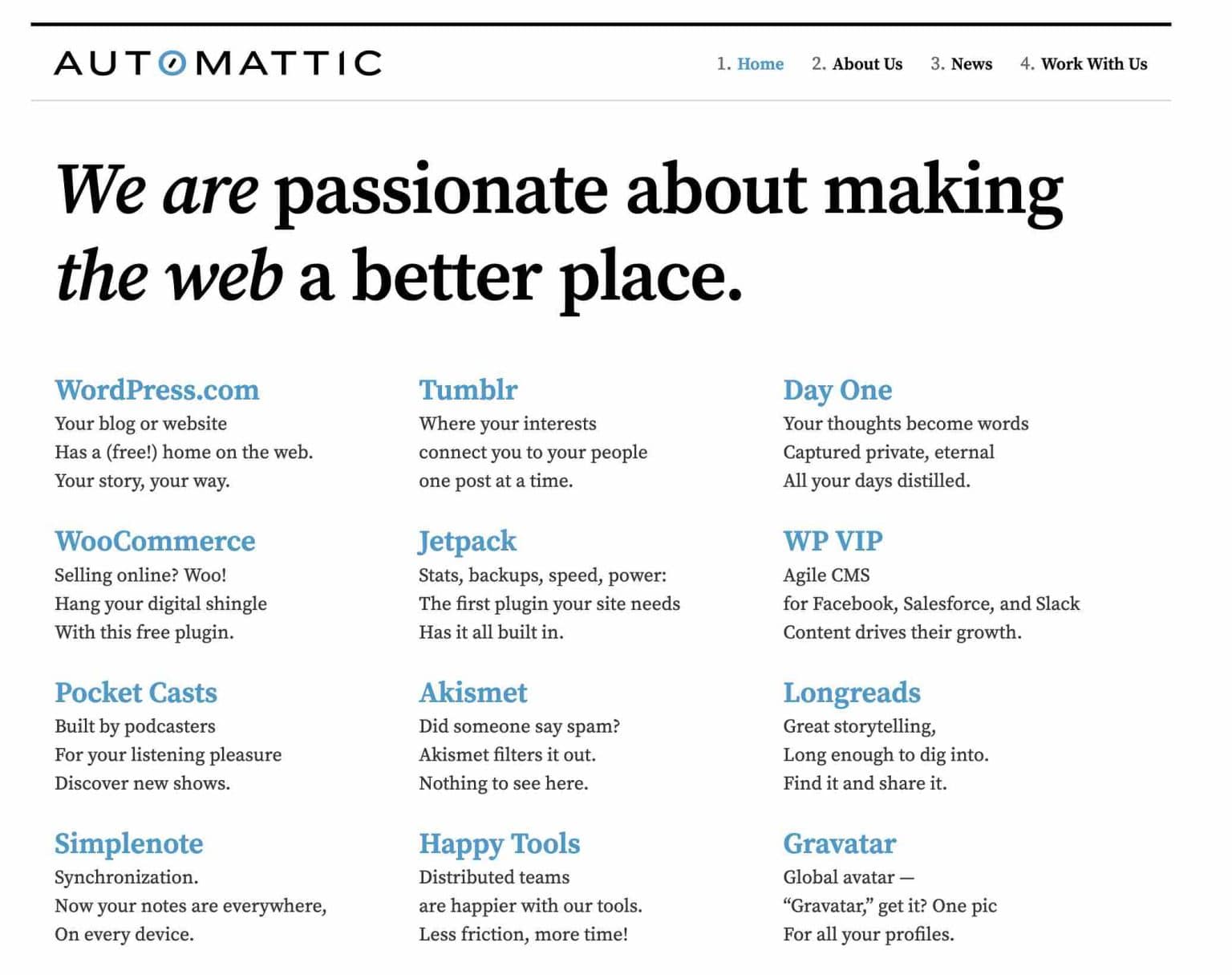
“We are passionate about making the web a better place” Automattic members state that they don’t “make software for free, we make it for freedom”.
In addition to WordPress.com, Automattic also owns:
Automattic is also unique in that it has a strong corporate culture, where remote work is the norm. Since there is no HQ to speak of, everyone works where they want, when they want.
Valued at 3 billion dollars, Automattic also contributes financially to non-profit projects, such as WordCamp US.
It is impossible to tell the story of WordPress without mentioning WordCamps. A WordCamp is a WordPress event organized by the local user community.
Conferences and contribution sessions are organized, usually over 1 to 3 days.
The first WordCamp, organized by Matt Mullenweg, was held in San Francisco in August 2006.
At the time, Mullenweg summed up the concept on his personal blog: the idea is “a one day BarCamp-style free conference with a party that night. There will be free BBQ for lunch, WordPress t-shirts, and a full day of both user and developer discussion”.
If the substance has not changed, WordCamps have become more “professional” and an entrance fee is required to attend (around 20 dollars per day, on average, to help with the organization costs).
Since 2006, more than 1,100 WordCamps have been officially organized on 6 continents, in 65 countries and 375 different cities.

A WordCamp Europe is held every year in a new city, just like the WordCamp US. The latter is famous for hosting Matt Mullenweg’s annual State of the Word speech.
He takes the opportunity to review the developments of the past year, and the changes to come in the following year.
Besides the WordCamps, local meetings (or meetups) are also held around the world, as well as independent events.
A year later, in October 2007, Automattic made its mark with one of its major acquisitions: Gravatar.
Launched in 2005, Gravatar is a free service that allows users to manage their avatars on the web and to have “an effortless and verified way to establish their identity online”, as stated on its official website.
This is the avatar that is displayed in the administration and when someone comments on your WordPress site.
The United States have their number one news website about the CMS: WP Tavern.
It covers news and events, writes reviews of plugins and themes, and talks about key issues in the WordPress ecosystem.

Launched in January 2009 by Jeff Chandler, WP Tavern was acquired in June 2011 by the company Audrey, behind which we find… Matt Mullenweg.
“Audrey Capital is an angel investment and research firm created by WordPress’ Matt Mullenweg to help innovative ideas grow,” states their official website.
In 2010, the hyperactive Mullenweg decided to create the WordPress Foundation, a non-profit organization whose objectives include “guaranteeing free access, in perpetuity, to the software projects we support”.
On this occasion, Automattic transfers the ownership of the WordPress brand and logo to the Foundation, so that it can protect it.
In 2014, Automattic announced that it would now devote 5% of its time to developing the WordPress Core.
Mullenweg calls on all interested companies and individuals to do the same, joining the project dubbed “Five for the Future“.
Since its launch, participation has quadrupled, according to data made available by WordPress.
The year 2015 is pivotal in the history of WordPress. It was marked by the most important acquisition since the launch of Automattic, in 2005.
The major contributor to WordPress.org took over the South African company WooThemes, which edits the WooCommerce plugin, allowing WordPress to be transformed into an online store.
Through this move, WordPress wants to diversify and not only be considered as a blogging tool.
The goal, says Matt Mullenweg on his blog, is that “people can sell more easily online”.
WooCommerce (5+ million active installations) is now the most popular ecommerce plugin in the WordPress ecosystem: it runs on more than 9 out of 10 WP online stores. It is also the most used tool among the million most popular ecommerce sites on the planet.

One of the last major historical moves made by Automattic involved the acquisition of Tumblr in the summer of 2019.
In snapping up the microblogging platform, Automattic made what is its largest acquisition in terms of employees (200) and users (475 million blogs).
Since the launch of WordPress and the birth of its ecosystem, buyouts, mergers and other acquisitions have always been part of the landscape.
They happen frequently, whether they are large-scale or more confidential. In this respect, the year 2021 remains an exceptional year, with 45 acquisitions listed by the Post Status website, that is 1.5 per month!
And not the least, please (non-exhaustive list):
So far, we have discussed the past and present of the WordPress history. But what does the CMS have in store for us in the future?
To answer this question, a snapshot at the moment is already interesting. At the time of writing, WordPress is by far the most used tool in the world to design a website.
43.4% of the million sites that receive the most traffic are running on WordPress (.org and .com versions combined).
WordPress dominates the market with hegemony, leaving only crumbs to its main competitors: Shopify (4.3% market share), Wix (2.3%), Squarespace (2%), Joomla (1.7%) and Drupal (1.2%).
Its market share has been growing steadily for several years, but we note that its growth has slowed slightly since the first half of 2022.
Even more surprising, perhaps: WordPress even lost 0.3% of market share between March and April 2022.
Is this an isolated event or a trend that will continue? We’ll have to follow this over the next few months/years.
However, it is safe to say that it will not be dislodged from its position as the number one CMS for many years to come, if it happens at all.
Now its main competitors are self-hosted SaaS solutions like Shopify, Wix and Squarespace, which have taken over from the historical Joomla and Drupal.
Finally, a possible threat – to be taken with caution for the moment – could also come from within in the person of Elementor.
The most popular site builder in the WordPress ecosystem is growing exponentially. It’s used on more than 7% of the million sites that receive the most traffic.

While it obviously needs WordPress to function, it has recently diversified by offering its own cloud-based hosting service, to get closer to the WordPress.com model.
It is also putting its money where its mouth is on ecommerce features, to capitalize on a very strong demand since the beginning of the Covid-19 pandemic.
In any case, if it wants to fulfil its dreams of greatness and stand on its own two feet, it may have to break free from the WordPress ecosystem at some point.
As WordPress states on its official website, the software is “continually under development.
The goal of its developers is to continue to make WordPress a “software designed for everyone” that “focuses on accessibility, performance, security and ease of use”.
Over the next few months/years, the majority of the contributors’ efforts will be focused on Gutenberg. Improvements and evolutions are first planned on the Full Site Editing project, which is still in its early stages.
In this sense, we can also expect to see more and more block-based themes.
Then, Gutenberg will enter phases 3 and 4 of its long-term roadmap. Phase 3 will consist in strengthening collaboration, with the provision of more intuitive features to co-create content.
Finally, phase 4 will be dedicated to multilingualism, which is to be implemented in the WordPress Core.
Your best WordPress projects need the best host!
WPMarmite recommends Bluehost: great performance, great support. All you need for a great start.

Join 20k+ subscribers to get in-depth WordPress tutorials
and honest reviews (without jargon).
By subscribing to the newsletter, you consent to WPMarmite, in its capacity as data controller, collecting your data in order to send you communications electronically. You may unsubscribe at any time. To exercise your right of access, correction or deletion, please see our Privacy Policy.